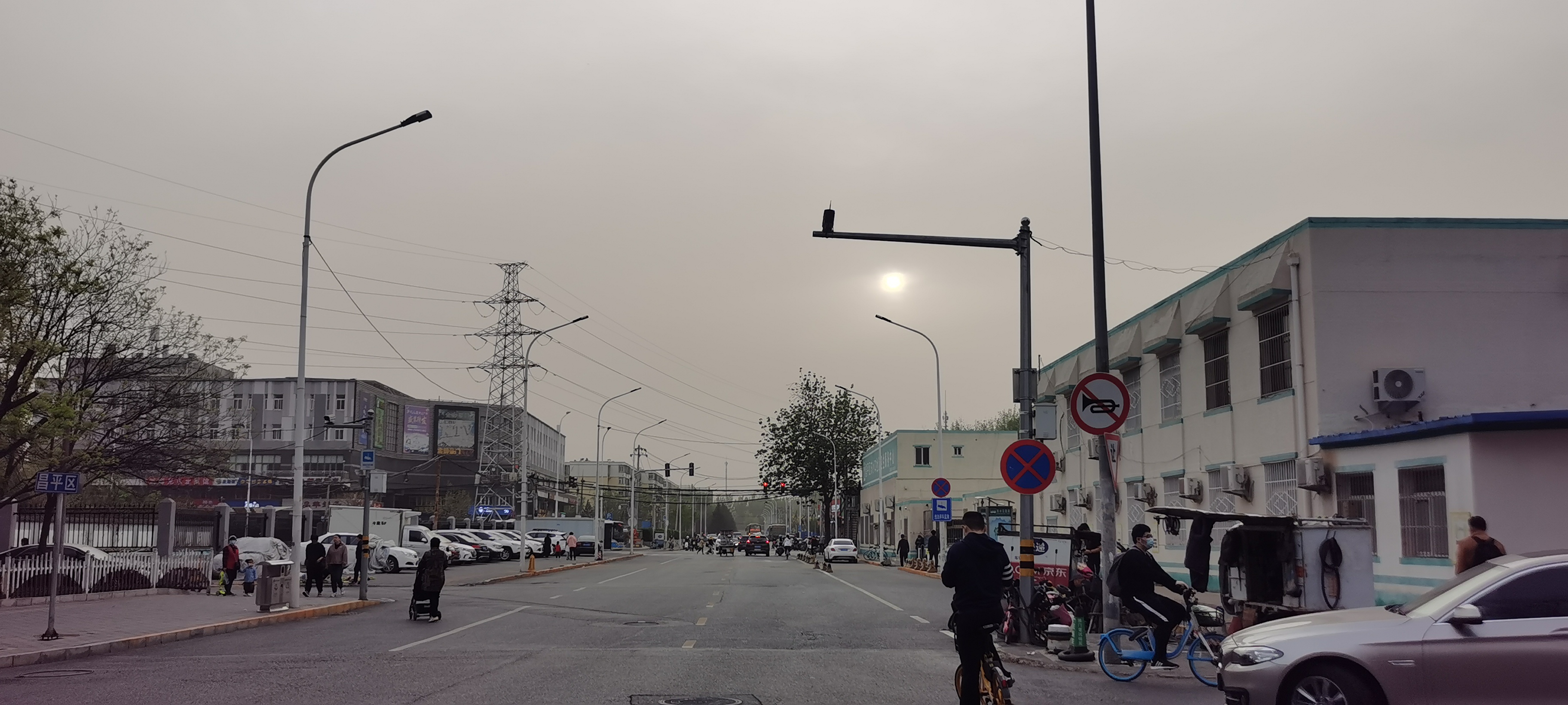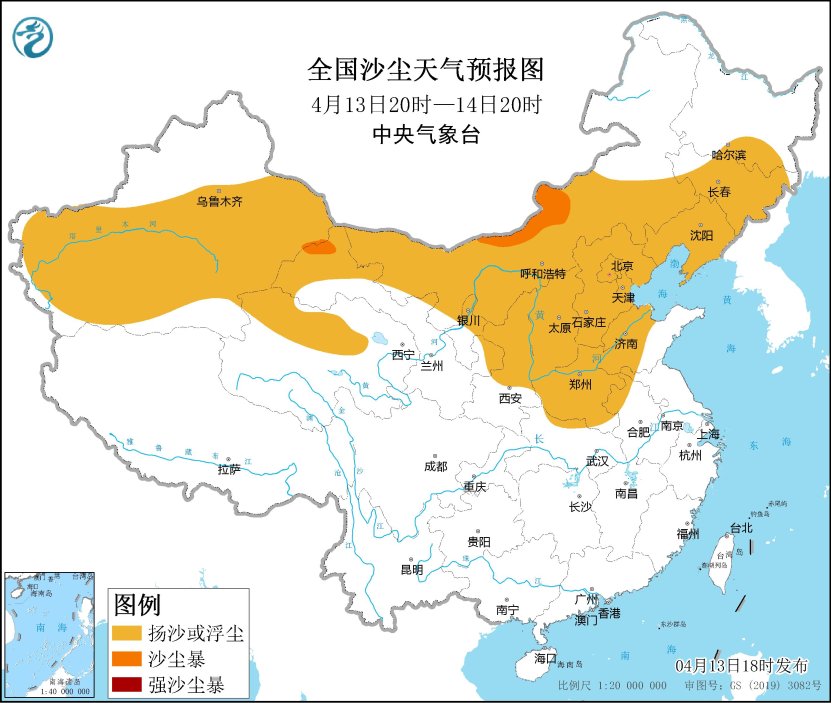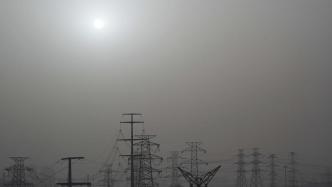

At 18:00 on April 13, near the Lishui Bridge in Changping District, Beijing. Wei Ketu
Sandstorms make people truly experience the feeling of "eating soil". Recently, the peak concentration of PM10 in many places in the north even exceeded 2000 micrograms per cubic meter.
On April 12, Li Xiang (pseudonym), who has been studying at Peking University for more than 5 years, told The Paper that the dusty smell outside has been very strong in recent days. When I went out, there was a lot of dust on my hair and clothes. When you come back, wash your hands as soon as possible, and wash your nasal cavity. He feels that this year's sandstorms are more frequent and more serious than previous years. He will take the initiative to reduce the time spent outdoors. If you have to go out, you must wear a mask and a hat.

On the evening of April 10, on the campus of Peking University. Photo provided by the interviewee
And according to the news posted on the official Weibo of China Weather Network, the sand and dust traveling all the way south arrived at Li Xiang's hometown - Jiangxi on the same day.
Shi Yan, a meteorological analyst at China Weather Network, said that Jiangxi and Hunan have caught up with the tail of the dust. This is the southernmost limit of this dust weather process. There is rain in the south of the Yangtze River, but it may be muddy rain.
In addition to the strong wind that plucks people's hair and the dust that captivates the eyes, the dust that is blown back after leaving is nicknamed "returning pot sand" by netizens. With the "blessing" of the southerly wind, the sand and dust traveling all the way south may be accompanied by the return flow and then go north to Beijing.
The eighth sandstorm this year, which began on April 9, still originated in Mongolia.
Wei Ke, an associate researcher at the Institute of Atmospheric Physics of the Chinese Academy of Sciences, told The Paper on April 13 that the height of the high-air flow transporting sand and dust is too high for the canopy of the shelterbelt to block it. "In addition to dealing with sand and dust within the country, we also have to deal with dust from abroad. The dust from within the country has been greatly reduced, and afforestation has played a big role. Otherwise, this sandstorm may be even more terrifying than it is now."
"Desert control", but also to go abroad.
The overseas dust sources of China's dust weather are mainly in Mongolia, Kazakhstan and Russia. The Gobi desert area in southern Mongolia is one of the most important sources of dust in China.
The Paper found that China and Mongolia have cooperated in desert control for a long time. Based on the cooperation, they are now taking capacity building projects as the forerunner to promote comprehensive desertification control and jointly build an ecological barrier in Northeast Asia.
Wei Ke suggested that cross-border "desert control" should not only rely on environmental protection projects such as tree planting, but also rely on economic means.

Li Xiang said that if you go out on a dusty day, your clothes will be covered with dust. Photo provided by the interviewee
It is the dust originating from Mongolia again, all the way south
According to the news from the Central Meteorological Observatory on April 12, as of now, there have been 8 sandstorm weather processes in my country, which is the most frequent in the same period in the past 10 years. The recent sand and dust weather has affected more than ten provinces, regions and cities in my country, but it is not over yet, and there is still sand and dust on the road.
Similar to the cause and origin of the dust weather process in late March, experts believe that this dust weather also started in Mongolia.
According to news from Xinhuanet on April 11, Gui Hailin, chief forecaster of the Central Meteorological Observatory, said that this is the second sandstorm that has affected my country this year. Affected by the dust weather process, the peak concentration of PM10 in many places in the north exceeded 2000 micrograms per cubic meter. The dust weather process started in the south of Mongolia on the afternoon of April 9. Subsequently, strong sandstorms occurred in Xilin Gol, Baotou, Ulanqab, Inner Mongolia, and Zhangjiakou, Hebei, and the minimum visibility was less than 50 meters. The Beijing Meteorological Observatory upgraded the blue dust warning signal to a yellow dust warning signal at 20:00 on April 10.
According to the China Green Times report, the severe sandstorm weather process that occurred from March 19th to 22nd mainly originated in southern Mongolia and southern Xinjiang of my country.
According to a report by Xinhua News Agency on March 26, three main conditions must be met for the formation of sand and dust weather: persistent strong winds, dust sources and instability of the lower atmosphere. Ding Ting, a researcher at the Climate Prediction Office of the National Climate Center, analyzed in the aforementioned report of Xinhua News Agency that the Gobi Desert in southern Mongolia is an important source of dust affecting my country. The vegetation growth season in 2022 will have less precipitation in Mongolia than in the same period in the past 20 years. The vegetation coverage of the sand sources is poor. "In addition, the frequent occurrence of sand and dust weather this year is mainly related to the recent abnormal atmospheric circulation." Ding Ting said that there was an extremely rare warming weather in early March that caused the sand in the permafrost layer to melt rapidly; In the high wind season, under certain strong wind conditions, the sand and dust from the sand source are transported to my country many times.
Zhang Bihui, director of the Environmental Meteorological Office of the Central Meteorological Observatory, said that it is expected that from April to May, there will be less precipitation in the sandy source areas from southern Mongolia to central and western Inner Mongolia of my country, and the temperature will be higher than normal in the same period of the year, and there will be Mongolian cyclones. Sandy weather.
Ding Ting said, "From the statistical results, the average number of sandstorms and sandstorms in northern my country from 2018 to 2022 are more than the average number from 2013 to 2017." Only once.
According to Wuhan Meteorological Weibo news, on the night of April 11, the air quality in Wuhan deteriorated rapidly, reaching the worst in the early morning.
According to the Weibo news of the Shanghai Meteorological Bureau, at around 21:00 on April 11, the PM10 concentration reached its peak - 800, and dropped significantly in the middle of the night. In dusty weather, floating dust, inhalable particles and fine particles will exist at the same time, and N95 and above protective masks can be worn.
According to the Weibo news of the Beijing Meteorological Bureau, the Beijing Meteorological Observatory continued to issue a blue sand and dust warning signal at 11:30 on April 13: At present, there is a sand and dust weather in this city, which is affected by the transmission of sand and dust in the upstream. It is expected that the sand and dust weather will continue Until 23:00 on the 14th, please take precautions.

Affected by the cold air and strong winds, it is expected that there will be sandstorms in parts of central and western Inner Mongolia and western Gansu from 20:00 on April 13 to 20:00 on April 14.
The Central Meteorological Observatory continued to issue a blue sandstorm warning at 18:00 on April 13: Affected by cold air and strong winds, it is expected that from 20:00 on April 13 to 20:00 on April 14, eastern Xinjiang and the southern Xinjiang Basin, central and western Inner Mongolia, Hexi, Gansu, and Qinghai. Parts of Dam Basin, northern Ningxia, central and northern Shaanxi, Shanxi, Hebei, Beijing, Tianjin, northern Shandong, Liaoning, Jilin, Henan and other places have blowing sand or floating dust weather. Among them, parts of central and western Inner Mongolia and western Gansu There are sandstorms.
Transnational "desert control" is "not a purely environmental issue"
Wei Ke, an associate researcher at the Institute of Atmospheric Physics of the Chinese Academy of Sciences, wrote in "Sandstorms are coming again, will afforestation not work?" "The article stated that sandstorms are not useless, they are part of the natural ecosystem. For example, about 28 million tons of dust from the Sahara Desert in Africa cross the ocean to South America every year, bringing about 22,000 tons of phosphorus fertilizer to the Amazon rainforest, thus nourishing and making up for the nutrients lost by the tropical rainforest. Although the sandstorms in northern my country have brought serious pollution, the dustfall of millions of years is the source of the deep loess layer in the north, and it also nourishes the fishing grounds in the Sea of Japan and the North Pacific.
But the dust weather still makes people feel uncomfortable.
Wei Ke told The Paper on April 13 that he tried not to go out in Beijing recently. If he had to go out, he would come in and out quickly to reduce the time spent outdoors. In addition, he hides whenever he can, and he even "hid" in Kunming a few days ago.

On the evening of April 10th, Beijing Fourth Ring Road. Photo provided by the interviewee
Why is this year's sandstorm so popular?
Wei Ke believes that in recent years, the public's awareness of environmental protection has increased, and their expectations for the ecological environment have also increased. Therefore, once sandstorms occur, everyone feels particularly serious. But compared with the 1960s and 1970s, both the number of occurrences and the intensity have weakened. However, this year's dust weather is indeed more frequent on the one hand, and lasts a bit longer on the other hand, so it has attracted public attention.
In response to the statement that "shelter forests cannot prevent sandstorms", Wei Ke told Pengpai Technology that it is not that afforestation will not be able to prevent wind and sand fixation, but that the height of sand and dust transported by high-air currents is too high for tree crowns to block. However, shelterbelts play the role of sand-fixing and sand-controlling. The sand sources of the recent sandstorms all came from abroad, not in our country.
In "The sandstorm is coming again, does afforestation not work?" "In the article, Wei Ke wrote that the Three North Shelterbelt Project is the most important measure for our country to deal with sandstorms. The Three Norths refer to the Northwest, North and Northeast regions. China's eight major deserts, four major sandy lands and the vast Gobi are distributed in the Three North Region, with a total area of 1.49 million square kilometers, accounting for about 85% of the country's wind-sandified land area. The Three-North Shelterbelt Project was established in 1979 and has been planned for 73 years and will be carried out in eight phases. At present, it has entered the sixth phase of the third phase of the project, and the time frame is from 2021 to 2030. By mid-century things should be much better than they are now. But the Three-North Shelterbelt cannot stop the high-altitude wind and sand transport. Because of this, before discussing my country's dust weather, it is necessary to discuss the ecological and environmental changes in the entire Central Asian region. The climate change in Mongolia has been very severe in recent years. The most obvious feature is that the temperature increase is more than twice the global temperature increase. In addition, the local precipitation has decreased, which has further aggravated the drought. Climate change in the Mongolian region may have broken through the climate tipping point. The climate critical point is equivalent to the top of the mountain. After pushing the stone over the top of the mountain, the stone will roll down by itself and cannot be stopped.
Wei Ke told The Paper on April 13 that, first of all, sandstorms are not only an environmental problem, but also an economic development problem. Mongolia needs to develop its economy, so there will be overgrazing and overexploitation. "This is due to its economic structural problems, so it may require the economic integration of the entire East Asia, or economic structural adjustment, high-quality development, etc. It is not a purely environmental problem. " Secondly, sandstorms are affected by larger spatial and temporal scales. impact of global climate change. In addition, there is excessive mining in some areas of Mongolia, and the main sales market for some of its ores is China, which is connected to our domestic supply chain.
Wei Ke explained that Mongolia is originally an extremely arid and semi-arid region. Most of the country has very little precipitation. The annual precipitation in the Gobi region in the south is even less than 50 millimeters, and the ecology is very fragile. In such places, if the climate tipping point is crossed, "it would be very exaggerated", and the impact would be more significant than elsewhere. However, in 2020, an analysis of a paper published in the academic journal "Science" stated that the temperature increase in the Mongolian region is much greater than the global average; in addition, its precipitation is also decreasing, and the drought Intensified, the combination of these factors has made the ecology of that place more fragile, so that article believes that the Mongolian region has broken through the critical point of climate .
Wei Ke believes that this also has important implications for us. Climate change will intensify environmental and ecological pressure and its vulnerability, and may destroy the achievements of ecological civilization such as environmental protection, biodiversity protection, and shelterbelt construction that we have worked hard for for decades. Once, with the support of science and technology, it is necessary to take more active measures in environmental protection and addressing climate change to achieve the progress of ecological civilization.
The secretariat of the "United Nations Convention to Combat Desertification" made it clear that the world's desertification control depends on China.
Wei Ke said that China has contributed Chinese experience and Chinese wisdom to global desertification control, and is further promoting ecological and environmental governance including desertification control. Mongolia and other regions are welcome to "copy operations"; Formal, multi-level economic and technological cooperation to promote industrial upgrading in relevant regions, especially advanced technologies in animal husbandry and extractive industries, to improve their production efficiency and environmental protection effects; more importantly, climate change requires global cooperation, which can be achieved through Existing cooperation mechanisms within the relevant work framework of the United Nations, coupled with its own efforts to mitigate climate change, can avoid more serious climate deterioration.
China-Mongolia Cooperation in "Desert Control"
"Environmental issues have no borders. China is willing to cooperate with Mongolia in environmental protection, desertification control and other aspects to meet challenges." On April 7, 2021, the Premier of the State Council of China and the Prime Minister of Mongolia said during a phone call.
According to information released on the official website of the State Forestry and Grassland Administration, in March 2021, multiple sandstorms affected Mongolia and northern China. In April 2021, the State Forestry and Grassland Administration and the Mongolian Ministry of Environment and Tourism held a special meeting on desertification prevention and control of the China-Mongolia Forestry Working Group in the form of a video conference. China and Mongolia respectively exchanged views on the causes of desertification in sand and dust source areas, monitoring and control of soil desertification, and technical models and experience in sand and dust source area control. The two sides agreed to send expert teams to conduct field research and technical exchanges at an appropriate time, and set up a desertification prevention and control working group to continue to promote practical cooperation in desertification prevention and control.
According to a report by China Green Times in December 2022, the overseas dust sources of China's dust weather are mainly in Mongolia, Kazakhstan and Russia. Among them, the impact of sandstorms originating from the Gobi Desert in southern Mongolia on the Inner Mongolia Autonomous Region It is the most prominent and has a considerable impact on North China, Northeast China, and East China. It is one of the most important sources of sand and dust affecting China's sand and dust weather.
According to the report, China and Mongolia have cooperated in sand control for a long time. In 2012, 12 people led by the Secretary-General of the Mongolian National Committee for Desertification Prevention and Control visited the Chinese Academy of Forestry, and the two sides conducted exchanges and discussions on desertification prevention and control technology models. Since 2013, the State Forestry Administration of China has organized research institutes such as the Desertification Research Institute of the Academy of Forestry to hold multiple desertification prevention and control seminars for Mongolia to promote mutual learning of desertification control experience between China and Mongolia. Since 2017, under the guidance of China's desertification control department, Professor Wang Xinping of the Chinese Academy of Sciences, as the technical leader, has carried out demonstrations of China's typical sand control technologies in the southern part of Mongolia's Bulgan Province. The control demonstration area has reached 27 hectares, effectively fixing the local mobile and semi-mobile sand dunes , herbaceous plants in the demonstration area increased significantly.
On November 28, 2022, when the Chinese state leaders held talks with the Mongolian President, they proposed that they would "discuss with the Mongolian side the establishment of a China-Mongolia desertification prevention and control cooperation center".
According to the official website of the National Forestry and Grassland Administration, from September 22 to 26, 2022, the Desertification Control Department of the National Forestry and Grassland Administration of China, together with relevant experts from the Chinese Academy of Sciences, went to the Inner Mongolia Autonomous Region to investigate and inspect the effectiveness of cooperation projects with Mongolian National Defense and Desertification Control. On September 30, the Department of International Cooperation and the Department of Desertification Control of the National Forestry and Grassland Administration of China, the Ministry of Environment and Tourism of Mongolia, and the Mongolian Embassy in China held a special meeting on desertification prevention and control of the China-Mongolia Forestry Working Group in the form of video. Both China and Mongolia agreed that on the basis of existing cooperation, we should take capacity building projects as the forerunner and promote expert exchange visits and field demonstrations of desertification prevention and control engineering technologies in due course.
On November 21, 2022, the technical training course on land degradation and desertification prevention and control in Mongolia, sponsored by the International Cooperation Department of the National Forestry and Grassland Administration and undertaken by the Institute of Ecological Protection and Restoration of the Chinese Academy of Forestry, was held online via video. The purpose of this training course is to actively implement the important consensus reached by President Xi Jinping and the President of Mongolia on supporting Mongolia's "planting 1 billion trees" plan and carrying out China-Mongolia cooperation in desertification prevention and control, and publicize and disseminate my country's desertification through online courses and cloud visits. The policies, models and great achievements of desertification prevention and control have helped Mongolia to promote the comprehensive management of desertification prevention and control with practical actions, and jointly build an ecological barrier in Northeast Asia.
According to the above news, the content of the training course covers the overall plan and practice of desertification prevention and control in China, policy support and great achievements, low-coverage sand control technology, research and development and application of sand dune afforestation technology, the impact of Mongolian plateau grassland degradation on ecosystems, artificial The application and practice of intelligence in desertification monitoring, as well as the report and implementation of land degradation zero growth supported by big data and artificial intelligence. In addition, the management status of Ulan Buhe Desert and Kubuqi Desert in my country was broadcast live online in the form of cloud tour , and the city of Kangbashi built on the desert. A total of more than 140 people from the Mongolian Forestry Research and Development Bureau, the Ministry of Environment and Tourism of each province, the National University of Mongolia, and the Institute of Geography and Geoecology of the Mongolian Academy of Sciences signed up for the meeting.
In addition, according to the official website of the State Forestry and Grassland Administration, on April 18, 2018, China and Mongolia signed an implementation agreement on the Gobi Bear Technical Assistance Project in Mongolia, and the Chinese side will provide funds and technology free of charge to carry out Gobi bear technology in Area A of the Mongolian Great Gobi Reserve. Bear Conservation Technical Assistance Project. In the four years since the project was implemented, the latest results show that the number of Gobi bears has increased from 23 in 2009 to 52. On December 14, 2022, the International Department of the State Forestry and Grassland Administration and the Chinese Academy of Forestry jointly held a report meeting on Mongolia's Gobi Bear Technical Assistance Project through an online meeting.

